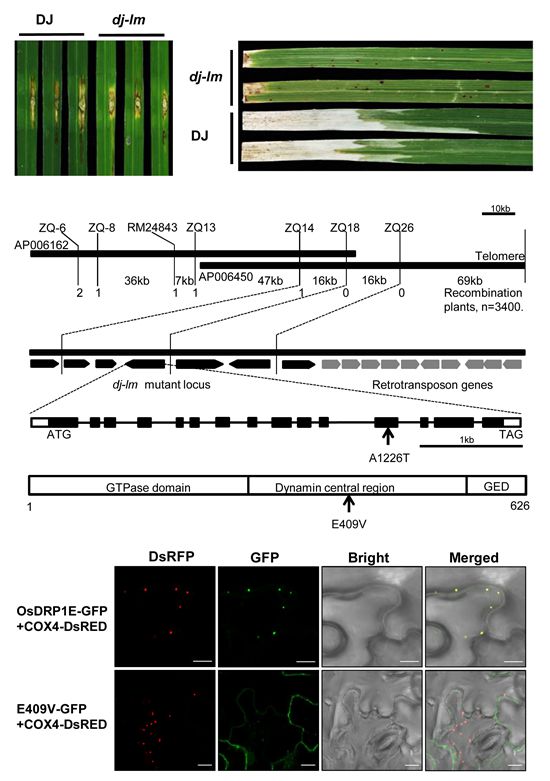分享到
The Rice Dynamin-related Protein OsDRP1E Negatively Regulates Programmed Cell Death by Controlling the Release of Cytochrome c from Mitochondria
To death or not, is controlled by the processes of PCD (programmed cell death) in animals and plants. PCD plays important roles in growth and development, as well as biotic or abiotic stresses. The lesion mimic mutation in plants, which leads to spontaneous formation of cell death in the absence of infection by exogenous pathogens, induces the expression of resistance-related genes and increases plant defense against insect pests and diseases. Understanding of the mechanism of plant PCD provides the molecular basis for developing new resistance materials in crop breeding. Recently, research groups from the State Key Laboratory for Biology of Plant Diseases and Insect Pests, Institute of Plant Protection of CAAS have discovered a Dynamin related protein (DRP) which plays a negative role in the rice PCD, and they published their findings on the open accessed journal PLoS Pathogens.

Phenotype, map based cloning and subcellular localization of the rice DRP1E

Phenotype, map based cloning and subcellular localization of the rice DRP1E
In their study, they began with a rice mutant dj-lm (dongjin lesion mimic) and performed thoroughly genetic, biochemical and cellular biological analysis. The dj-lm mutant showed cell death phenotype from seedling stage to maturation stage and led to enhanced resistance to the rice blast pathogen Magnaporthe oryzae and the bacterial blight pathogen Xanthomonas oryzae pv. oryzae. Confirmed with a map-based cloning approach, the E409V mutation of OsDRP1E resulted in cell death and resistance to pathogens. Further functional analysis showed that the specific E409V mutation of OsDRP1E affected its intrinsic GTPase activity and loss of mitochondrial localization. The present study, which found that the abnormal release of cytochrome c from mitochondria controls PCD, sheds light for further understanding of DRP-like proteins involved in the molecular mechanism of PCD and signal transduction of disease resistance in rice.
For more information on the research, please go to the following link:
http://journals.plos.org/plospathogens/article?id=10.1371/journal.ppat.1006157
For more information on the research, please go to the following link:
http://journals.plos.org/plospathogens/article?id=10.1371/journal.ppat.1006157
By Bo Ding
bding@ippcaas.cn
bding@ippcaas.cn
Latest News
-
 Apr 18, 2024Opening Ceremony of the Training Workshop on Wheat Head Scab Resistance Breeding and Pest Control in Africa Held in CAAS
Apr 18, 2024Opening Ceremony of the Training Workshop on Wheat Head Scab Resistance Breeding and Pest Control in Africa Held in CAAS -
 Apr 03, 2024IPPCAAS Co-organized the Training Workshop on Management and Application of Biopesticides in Nepal
Apr 03, 2024IPPCAAS Co-organized the Training Workshop on Management and Application of Biopesticides in Nepal -
 Mar 28, 2024Delegation from the School of Agriculture and Food Science of University College Dublin, Ireland Visit to IAS, CAAS
Mar 28, 2024Delegation from the School of Agriculture and Food Science of University College Dublin, Ireland Visit to IAS, CAAS -
 Mar 25, 2024Director of World Food Prize Foundation visited GSCAAS
Mar 25, 2024Director of World Food Prize Foundation visited GSCAAS -
 Mar 20, 2024Institute of Crop Sciences (ICS) and Syngenta Group Global Seeds Advance Collaborative Research in the Seed Industry
Mar 20, 2024Institute of Crop Sciences (ICS) and Syngenta Group Global Seeds Advance Collaborative Research in the Seed Industry
